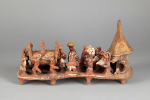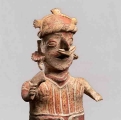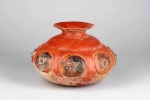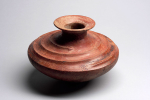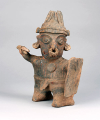West Mexico: Ritual and Identity, organized by Gilcrease Museum, will feature a spectacular selection of ceramic figures and vessels from the Gilcrease collection, augmented by items from public and private collections.
Better known today as a sunny vacation destination and the home of tequila, West Mexico’s past is a fascinating story that dates back more than 2,000 years, around the time that Teotihuacán (near present day Mexico City) was emerging as the most important city in the Americas. Due to its sizable population, stature as a religious center and apartment-style dwellings, this city was a cultural center in its day. Meanwhile, another vibrant society, the Teuchitlán (commonly known by social scientists as the “Shaft Tomb” culture), was developing between Guadalajara and the west coast of Mexico in what is now Nayarit and Jalisco. This land of mild climate offered abundant fresh water, rich soils, mineral wealth and access to the resources of the ocean and the mountains.
Large, expressive ceramic figures frequently were part of the ritual items deposited in shaft tombs. Ceramic human figures adorned with brightly colored clothing, tattoos and body paint provide an intimate look at men and women of the culture, along with a variety of animals, birds, fish and reptiles. In the 1940s and ’50s, Thomas Gilcrease amassed a collection of more than 500 ceramic figures and vessels from West Mexico, including two significant human figures, each more than 30 inches in height, and among the finest figures from the region.
This exhibit will examine and interpret the art and artifacts of the shaft tomb culture that flourished in West Mexico 300 BC-500 AD, bringing together the most current research from the field, scientific laboratories and objects to re-create life, death and ritual.
With large scale murals of these settlements complementing the objects on display, the exhibition will examine the various forms of sculpted vessels, paying particular attention to the human forms, which tell a rich story of a culture predating the more widely known Aztecs, but equally as fascinating and arguably more influential.


